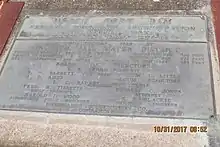Pacheco Reservoir
Pacheco Reservoir is an artificial lake or reservoir in the Diablo Range in California, U.S.A., formed by a dam on the north fork of Pacheco Creek. Located north of State Route 152 in eastern Santa Clara County, the lake is about an hour's drive from downtown San Jose.
| Pacheco Lake | |
|---|---|
 Pacheco Lake  Pacheco Lake | |
| Location | Diablo Range, eastern Santa Clara County, California |
| Coordinates | 37°03′41″N 121°17′41″W[1] |
| Type | Reservoir |
| Primary outflows | North Fork Pacheco Creek[2] |
| Catchment area | 67.2 sq mi (174 km2)[2] |
| Basin countries | United States |
| Max. length | 2 miles (3.2 km) |
| Max. width | 1,500 feet (460 m) |
| Surface area | 197 acres (80 ha)[2] |
| Water volume | 6,150 acre feet (7,590,000 m3)[2] |
| Surface elevation | 476 feet (145 m)[1] |
The lake is formed by a dam across the north fork of Pacheco Creek, whose waters reach Monterey Bay by way of the Pajaro River.
North Fork Dam
| North Fork Dam | |
|---|---|
 Plaque atop the North Fork Dam at Pacheco Reservoir | |
| Country | United States |
| Location | Santa Clara County, California |
| Coordinates | 37°3′1″N 121°17′29″W |
| Opening date | 1939[2] |
| Owner(s) | Pacheco Pass Water District[2] |
| Dam and spillways | |
| Type of dam | Earthen[2] |
| Impounds | Pacheco Creek[2] |
| Height | 100 feet (30 m)[2] |
| Length | 600 feet (180 m)[2] |
| Elevation at crest | 483 feet (147 m)[2] |
| Width (crest) | 20 feet (6.1 m)[2] |
| Dam volume | 325,000 cubic yards (248,000 m3)[2] |
| Reservoir | |
| Creates | Pacheco Lake |
| Total capacity | 6,150 acre feet (7,590,000 m3)[2] |
| Catchment area | 67.2 square miles (174 km2)[2] |
| Surface area | 197 acres (80 ha)[2] |
| Maximum length | 2 miles (3.2 km) |
| Maximum width | 1,500 feet (460 m) |
| Normal elevation | 476 feet (145 m)[1] |
The lake's waters are impounded by the North Fork Dam, an earthen dam built in 1939. The dam is 100 feet (30 m) high and 600 feet (180 m) long and contains 325,000 cubic yards (248,000 m3) of material. Its crest is 483 feet (147 m) above mean sea level.[2]
The reservoir dam is an impassable barrier to in-migrating steelhead trout (Oncorhynchus mykiss), preventing access to the nearly 34.5 miles (55.5 km) of stream consisting of North Fork Pacheco Creek, Mississippi Creek and East Fork Pacheco Creek.[3] Resident rainbow (the landlocked form of steelhead) trout successfully rear in fast-water habitats above the dam. They grow rapidly and reach smolt size by the end of their first summer. In many years in late spring, prior to reservoir releases for agriculture, low stream flows and high water temperatures severely impact steelhead fry and small juveniles.[4]
Pacheco Reservoir Expansion Project
In 2018, the Santa Clara Valley Water District (known as "Valley Water"), Pacheco Pass Water District, and San Benito County Water District were awarded $484.5 million from California’s Water Quality, Supply and Infrastructure Improvement Act of 2014 to expand Pacheco Reservoir from its current operational capacity of 5,500 Acre-foot to 140,000 acre-feet.[5] [6] The expansion project involves building an earthen dam made of rock and soil upstream of the existing dam, a pump station, a pipeline, and other related infrastructure. The total project cost is projected to be $969,000,000.[7]
In addition to runoff from the North Fork Pacheco Creek watershed, the reservoir will store imported water pumped from the San Luis Reservoir, which is located to the east along Highway 152 and is part of the Central Valley Project (CVP) San Felipe Division in Merced and Santa Clara counties. The imported water would be supplied by the United States Bureau of Reclamation under contract to Valley Water and the San Benito County Water District.[7]
In a drought or other emergency, the increased storage capacity will supply up to 1.4 million residents with water for a year.[8] Water flow from the reservoir into Pacheco Creek will be managed to keep the creek flowing and improve the quality of habitat for South Central California Coast steelhead trout. Eight wildlife refuges in Central California will also be supplied with water.[7][9]
Valley Water is currently exploring the project design and evaluating environmental impacts under a cost-sharing agreement with the California Water Commission. The draft environmental impact report is expected by 2022, with construction expected to begin in 2024.[8][7]
See also
- List of dams and reservoirs in California
- List of lakes in California
- List of lakes in the San Francisco Bay Area
References
- "Pacheco Lake". Geographic Names Information System. United States Geological Survey.
- "Dams Within the Jurisdiction of the State of California (N-S)" (PDF). California Department of Water Resources. Archived from the original (PDF) on October 5, 2012. Retrieved September 29, 2012.
- U.S. Geological Survey. National Hydrography Dataset high-resolution flowline data. The National Map, accessed February 6, 2016
- Jerry Smith (2007). Effects of Operation of Pacheco Reservoir on Steelhead (Report). San Jose State University. Retrieved 2016-02-06.
- "Pacheco Reservoir Expansion Project Awarded $485 Million State Grant". BenitoLink. 2018-07-26. Retrieved 2020-07-07.
- "Pacheco Reservoir Expansion Project | San Benito County Water District". Retrieved 2020-07-07.
- "Pacheco Reservoir Expansion Project". cwc.ca.gov. Retrieved 2020-07-07.
- "Pacheco Reservoir Expansion Project | Santa Clara Valley Water". www.valleywater.org. Retrieved 2020-07-07.
- Holtzclaw, Barry (2018-07-17). "Santa Clara Valley Water a Step Closer to Building $1 Billion Dam at Pacheco Pass Reservoir". San Jose Inside. Retrieved 2020-07-07.